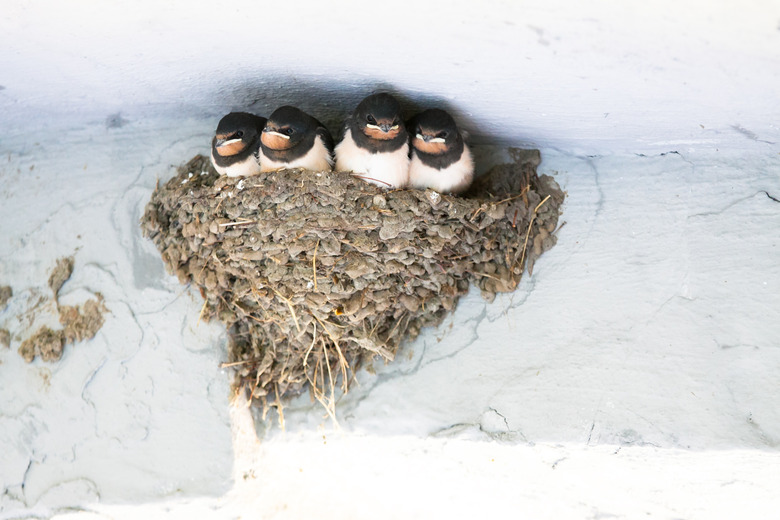Orphaned Barn Swallow Diets
Finding a baby barn swallow on the walk or porch steps creates a conundrum. Leaving it alone makes it prey for local cats and dogs as well as hawks. Rearing it takes time and effort. Actually, orphaned barn swallow babies can be safely returned to their nests. If this is not feasible — and as many states require a permit to have wild animals — the best option is to take the young bird to a local licensed ornithologist who raises wild birds. The last resort is to rear this orphan, and a little knowledge regarding its diet will aid in its survival.
Hatchling Diet
Hatchling Diet
Barn swallows are "atricial" which means that their hatchlings come from the egg naked, with their eyes closed and totally helpless. This stage of the bird's life lasts from hatching to day 3. If the hatchling is found at this time, do not feed it if it is chilled or cold. Warm it first by putting on a soft cloth on top of a heating pad or under a heat lamp. Keep the temperature between 95 and 100 degrees F. Rehydrate before feeding. To rehydrate, use an eyedropper and Pedialite, Gatoraid or distilled water. A drop of water on the tip of a paintbrush will also suffice.
Continue fluid therapy up to 72 hours if needed. Wait for the bird to defecate before feeding it. As the bird becomes hydrated, offer it cricket bodies that have been soaked in the rehydration solution. Victoria Bowers, the director of the Songbird Hospital of Sonoma County Wildlife Rescue in Sebastopol, Calif. advises not giving a hatchling any formula from the pet store because barn swallows require a 100 percent insect diet. For the first three days, feed it a puree of ground insects which consists of mealworms, fresh cricket bodies, frozen blood worms and rehydrated freeze-dried insects. This puree can be mixed in a blender to the consistency that can be drawn easily into a 1-cc syringe. Then administer the puree using a canula tip. If possible add an iota of adult barn swallow feces if possible. Also supplement this diet with a little yogurt, calcium and vitamins and pancrezyme. Purchase the vitamins and pancrezyme at a pet store and use an antacid for the calcium. Feed every 20 to 30 minutes for the first 12 to 14 hours, then let it sleep through the night. Start feeding at 7 a.m. and continue feeding every other hour until 9 p.m. with a total of eight feedings per day.
Nestling Diet
Nestling Diet
As the babies begin moving around the nest and gaping (holding their mouths open) for food, they are called "nestlings." This period is from day 1 to day 5 for young nestlings. Feed the youngsters tiny mealworms and crickets. Since mini crickets are so small, it is not necessary to remove the wings or legs. If these foods are not well-digested, go back to feeding the birds the hatchling diet mentioned previously. Feed the little ones as long as they continue gaping.
If a hand-feeding method is used, kitten kibble and other formulas that have high bio-available protein are viable alternative to the passerine puree used for hatchlings. Some pet stores offer 100 percent insect-based formulas.
Older nestlings, those at five days or older, eat 100 percent live insects such as mealworms and crickets. Add vitamin and calcium supplements. Dip an occasional insect in water before offering it, for hydration.
Fledgling Diet
Fledgling Diet
The young barn swallow is called a fledgling when it acquires flight feathers around day 20. In normal circumstances, it takes short trips out of the nest. At first it clings to a nearby branch of a tree while the parents feed it insects and bring it water. As the young bird gains strength it begins to fly out to meet the parent and receive sustenance from them in mid-flight. Orphaned fledglings need to be weaned slowly from any formula and onto a total insect diet of maggots, crickets, mealworms and other insects. They also require access to clean water.
Juvenile Diet
Juvenile Diet
Once the fledgling has full flight feathers it becomes a juvenile and requires the same diet as an adult barn swallow. Live mealworms, freeze-dried flies, freeze-dried crickets and a dish of dirt for minerals helps to digest tough mealworm exoskeletons. Juveniles must have flighted insects in order to learn how to capture food in a natural setting. Fruit flies can be captured from compost buckets containing rotting fruit. Purchase domestic fly pupae at a pet store and allowed to hatch into flies in the aviary.
Other Diets
Other Diets
Some home-remedy diets and commercial hand-feeding diets either recommend or use wet dog kibble. This is not a good idea according to Victoria Bowers, because dog kibble usually contains high amounts of grain, sugar and soy and is not high in animal protein like good kitten chow. These poor diets can result in poor development, dehydration, poor feather condition, MBD (Metabolic Bone Disease caused by calcium deficiency), failure to thrive and death.
Some people have successfully raised nestlings and fledglings on diets containing ox heart and scrambled eggs, minced meat, dead mealworms, insectivorous mix with vitamin/mineral supplements and high quality kitten chow with vitamin and calcium supplements.
References
Cite This Article
MLA
Yirka, Tonya. "Orphaned Barn Swallow Diets" sciencing.com, https://www.sciencing.com/orphaned-barn-swallow-diets-8108198/. 13 March 2018.
APA
Yirka, Tonya. (2018, March 13). Orphaned Barn Swallow Diets. sciencing.com. Retrieved from https://www.sciencing.com/orphaned-barn-swallow-diets-8108198/
Chicago
Yirka, Tonya. Orphaned Barn Swallow Diets last modified March 24, 2022. https://www.sciencing.com/orphaned-barn-swallow-diets-8108198/
